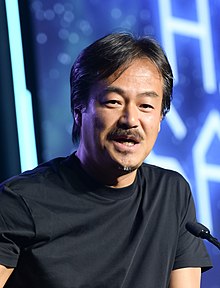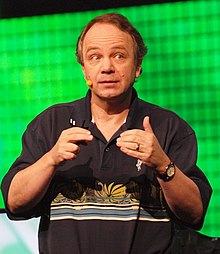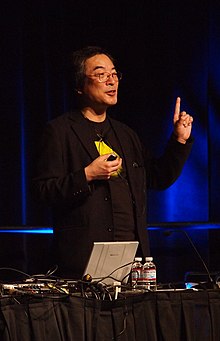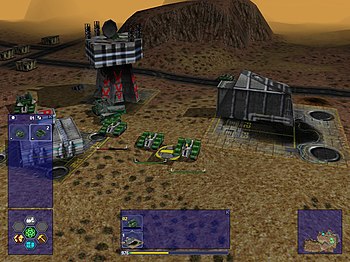Portal:Video games
The Video Games Portal

A video game, also known as a computer game or just a game, is an electronic game that involves interaction with a user interface or input device (such as a joystick, controller, keyboard, or motion sensing device) to generate visual feedback from a display device, most commonly shown in a video format on a television set, computer monitor, flat-panel display or touchscreen on handheld devices, or a virtual reality headset. Most modern video games are audiovisual, with audio complement delivered through speakers or headphones, and sometimes also with other types of sensory feedback (e.g., haptic technology that provides tactile sensations). Some video games also allow microphone and webcam inputs for in-game chatting and livestreaming.
Video games are typically categorized according to their hardware platform, which traditionally includes arcade video games, console games, and computer (PC) games; the latter also encompasses LAN games, online games, and browser games. More recently, the video game industry has expanded onto mobile gaming through mobile devices (such as smartphones and tablet computers), virtual and augmented reality systems, and remote cloud gaming. Video games are also classified into a wide range of genres based on their style of gameplay and target audience. (Full article...)
Featured articles –
Set in a world with technology resembling the Second Industrial Revolution, the game's story follows an expanding cast that includes fourteen permanent playable characters. The game's themes of a rebellion against an immoral military dictatorship, pursuit of a magical arms race, use of chemical weapons in warfare, depictions of violent and apocalyptic confrontations, several personal redemption arcs, teenage pregnancy, and the renewal of hope and life itself, indicated as a groundbreaking opposite of the entire narrative due to its progressive darker and more mature themes than earlier franchise.
Final Fantasy VI received widespread critical acclaim, particularly for its graphics, soundtrack, story, characters, and setting. It is widely considered to be one of the greatest video games ever made, and is often cited as a watershed title for the role-playing genre. The game was a commercial success, with the Super NES and PlayStation versions selling over 3.48 million copies worldwide by 2003, as well as over 750,000 copies as part of the Japanese Final Fantasy Collection and the North American Final Fantasy Anthology. (Full article...)

Wii Sports is a 2006 sports simulation video game developed and published by Nintendo for the Wii video game console. The game was released in North America along with the Wii on November 19, 2006, and in Japan, Australia, and Europe the following month. It was included as a pack-in game with the console in all territories except Japan, making it the first sports game included with the launch of a Nintendo system since Mario's Tennis for the Virtual Boy in 1995. The game was later released on its own as part of the Nintendo Selects collection of games.
Wii Sports is a collection of five sports simulations designed to demonstrate the motion-sensing capabilities of the Wii Remote. The five sports included are tennis, baseball, bowling, golf, and boxing. Players use the Wii Remote to mimic actions performed in real-life sports, such as swinging a tennis racket or rolling a bowling ball. The rules for each game are simplified to make them more accessible to new players. The game also features training and fitness modes that monitor players' progress in the sports.
Wii Sports was well-received by critics and audiences, and is considered one of the greatest games of all time. It was also a commercial success, selling 82 million copies worldwide, becoming the best-selling Nintendo video game, as well as the third-best-selling video game of all time and the best-selling game exclusive to one console. It has been featured on television in Wii commercials, news reports, and other programming. The game has become a popular means for social gatherings and competitions among players of varying ages. (Full article...)
As a spiritual successor to Rare's 1997 first-person shooter GoldenEye 007, Perfect Dark shares many features with its predecessor and runs on an upgraded version of its game engine. GoldenEye 007 director Martin Hollis led the game's production for the first fourteen months of its near three-year development cycle before he left Rare to pursue other interests. The game is one of the most technically-advanced titles for the Nintendo 64, and requires an Expansion Pak to access the campaign mode and most of the multiplayer features. Shortly before the game's release, a feature that would have allowed players to place a photograph of their choice onto the face of their multiplayer character was cut due to sensitive issues surrounding the ability for players to attack images of real people.
Upon release, Perfect Dark received critical acclaim and sold relatively well, eventually joining Nintendo's "Player's Choice" game selection. Critics widely praised its graphics, artificial intelligence, and number of multiplayer options, but some criticised its inconsistent frame rate. The game received the BAFTA Interactive Entertainment Moving Images Award for 2000 and the Golden Satellite Award for Best Interactive Product in 2001. The game is occasionally cited as one of the greatest video games of all time. It was supplemented by a Game Boy Color counterpart, which allows some gameplay options to alternatively be unlocked via a Transfer Pak. A remaster, also titled Perfect Dark, featuring enhanced graphics and online multiplayer, was released in 2010 for the Xbox 360. The game was re-released on the Nintendo Switch Online + Expansion Pack via the Mature 17+ app in June 2024. (Full article...)
Did you know... -
- ... that the Chicago Sun-Times credits JumpStart Toddlers as the first video game targeted towards babies?
- ... that classified documents of the United States were partially leaked onto a Discord server for the video game Minecraft?
- ... that the 1999 video game Interplay Sports Baseball Edition 2000 used a public-address announcer while its rivals were switching to two commentators as featured on real MLB game broadcasts?
- ... that the urban legend Herobrine was ranked on a Guinness World Records poll of the best video game villains, despite never existing?
- ... that a cheat code for the 2003 video game Hulk is hidden in a scene of the film it is based on?
- ... that Terra Invicta's development company is a group of former volunteer video game modders that decided to release their own game after the success of their mod?
- ... that the video game Pyongyang Racer was developed in North Korea for Koryo Tours, which organises tours to the country?
- ... that a reviewer thought that the video game Robbery Bob contained cringeworthy dialogue?
- ... that the name of the video game mod series Bomba Patch was inspired by éclairs?
- ... that for at least 90 minutes, Mori Calliope livestreamed herself begging video game developer Atlus to allow her to stream their game Persona 3?
- ... that a video game consisting solely of a clickable image of a banana was briefly the second-most played game on Steam?
- ... that the video game Fursan al-Aqsa received an update that allows players to reenact the October 7 attacks on Israel?
Selected biography –
Selected image -
Recent video game-related events
- September 12, 2024 – 2023–2024 video game industry layoffs
- Microsoft announces that it will lay off 650 Microsoft Gaming employees as part of cuts to its workforce. (Variety)
- August 15, 2024 –
- American video game magazine Game Informer discontinues publication after 33 years. The magazine's website is also shut down. (BBC News)
- May 24, 2024 – Uvalde school shooting
- Families in Uvalde, Texas, U.S., file a lawsuit against Daniel Defense and Activision Blizzard for creating the DDM4 V7 gun and promoting the weapon through the game Call of Duty, respectively. They also sue Meta Platforms for owning Instagram, which was used by the gunman. (AP)
Topics
Categories
Things you can do
In other Wikimedia projects
The following Wikimedia Foundation sister projects provide more on this subject:
-
Commons
Free media repository -
Wikibooks
Free textbooks and manuals -
Wikidata
Free knowledge base -
Wikinews
Free-content news -
Wikiquote
Collection of quotations -
Wikisource
Free-content library -
Wikiversity
Free learning tools -
Wiktionary
Dictionary and thesaurus














































